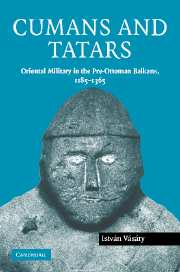Book contents
- Frontmatter
- Contents
- Preface
- 1 Introduction
- 2 Cumans and the Second Bulgarian Empire
- 3 Cumans in the Balkans before the Tatar conquest, 1241
- 4 The first period of Tatar influence in the Balkans, 1242–1282
- 5 The heyday of Tatar influence in the Balkans, 1280–1301
- 6 Cumans and Tatars on the Serbian scene
- 7 Cumans in Byzantine service after the Tatar conquest, 1242–1333
- 8 The Tatars fade away from Bulgaria and Byzantium, 1320–1354
- 9 The emergence of two Romanian principalities in Cumania, 1330, 1364
- Conclusion
- Appendix 1 List of geographical names
- Appendix 2 Chronological table of dynasties
- Appendix 3 Maps
- List of abbreviations
- Bibliography
- Index
2 - Cumans and the Second Bulgarian Empire
Published online by Cambridge University Press: 29 July 2009
- Frontmatter
- Contents
- Preface
- 1 Introduction
- 2 Cumans and the Second Bulgarian Empire
- 3 Cumans in the Balkans before the Tatar conquest, 1241
- 4 The first period of Tatar influence in the Balkans, 1242–1282
- 5 The heyday of Tatar influence in the Balkans, 1280–1301
- 6 Cumans and Tatars on the Serbian scene
- 7 Cumans in Byzantine service after the Tatar conquest, 1242–1333
- 8 The Tatars fade away from Bulgaria and Byzantium, 1320–1354
- 9 The emergence of two Romanian principalities in Cumania, 1330, 1364
- Conclusion
- Appendix 1 List of geographical names
- Appendix 2 Chronological table of dynasties
- Appendix 3 Maps
- List of abbreviations
- Bibliography
- Index
Summary
THE ANTECEDENTS AND OUTBREAK OF THE LIBERATION MOVEMENT
The first half of the twelfth century was the last great flourishing period of Byzantine history. During the reign of Manuel Komnenos (1143–1180), the first signs of decadence were to be seen, and from then onwards a speedy decline led to Constantinople's capture by the Latins. Byzantium's decay in the second half of the twelfth century can be ascribed to several factors, both external and internal. By the twelfth century Byzantium was not the unrivalled world power it had been before. The emergence and development of Western European cities, especially those of Italy, severely menaced Byzantium's hegemony in the world economy. Byzantine manufacture underwent serious decay, and Byzantium's economic power decreased in every respect. Although the Komnenoi tried to pursue the old imperial policy, the re-establishment of the unity of the Roman Empire was a daydream at that time. Nevertheless, this imperial policy demanded significant financial resources, and the Komnenoi emperors did not hesitate to seize every possible means of extorting more money from the population. Taxes and levies were increasing all the time, and the pauperisation of both peasants and city-dwellers proceeded rapidly. To make the contrast even sharper, the corruption of the state apparatus further aggravated the difficult situation of the population. The employment of great numbers of mercenary troops considerably contributed to the moral degeneration of the army.
- Type
- Chapter
- Information
- Cumans and TatarsOriental Military in the Pre-Ottoman Balkans, 1185–1365, pp. 13 - 56Publisher: Cambridge University PressPrint publication year: 2005

